Kodak Brownie Hawkeye
| Kodak Brownie Hawkeye | ||
|---|---|---|
Manufacturer: Kodak Date of Production: 1949-61 Type of Camera: Box Lens: Single Element Meniscus Focal length: 81mm Aperture: f/15 Shutter: Rotary Shutter speeds: Instant or Bulb Viewfinder: Waist level finder Tripod socket: No Cable release thread: No |
The Kodak Brownie Hawkeye is a Bakelite box camera that takes 6x6cm images on 620 film, made in the USA and France by Kodak, between 1949-1961.[1] There were also examples labelled "Brownie Fiesta" and "Brownie Flash". The original design did not have a flash facility, but the Flash model was added in 1950 and called the Brownie Flash in France and the Kodak Brownie Hawkeye Flash in the USA. Earlier models of the camera have a metal film advance knob; later models have a knurled plastic knob.
The camera is compact, box shaped, with a carrying handle on top and a winding knob to the photographer's right. The design aesthetic is a throw-back to the Art Deco era of the 1920's, with clean minimalist fluting on the sides and an attractively-designed front. This camera is the work of an Arthur H Crapsey, who designed other plastic box cameras with similar aesthetics such as the Kodak Brownie Bull's-Eye and the Kodak Brownie Star series, as well as some more advanced cameras for Kodak in the 40's and 50's.
The camera has a brilliant waste-level finder, which has a fairly similar lens to the taking lens and thus provides a fairly accurate preview of the exposure. It also features a switch (opposite the shutter-release) which allows "bulb" exposure, though no tripod socket is provided to steady the camera during long exposure shots. The precise speed of the shutter is unknown, but it is thought to be between 1/30th and 1/50th of a second.
The flash-holder provided with the American version of the Hawkeye Flash is the "Midget," which is the same one sold with the Brownie Starlet, Brownie Starflex and Brownie Bull's-Eye. This unit must be attached without a bulb or without batteries. Otherwise, it will most likely fire in the process of being attached. Other name variants exist.
- Models Produced:
- Non-Flash Models: May 1949 - November 1951
- Flash Models: September 1950 - July 1961
- Original Price:[2]
- Camera: $7
- Flash unit: $4
How to tell when a Kodak Brownie Hawkeye was made
Kodak used a system whereby the manufacture date of each camera can be ascertained. If one removes the back of the camera to examine the underside, where the exposed film spools go, one spots four letters printed in silver. These letters correspond to dates, using Kodak's code word "CAMEROSITY":
| C | A | M | E | R | O | S | I | T | Y |
| 1 | 2 | 3 | 4 | 5 | 6 | 7 | 8 | 9 | 0 |
If a camera, for instance, has the letters CARM, it was manufactured in 12/53. Kodak used 13 4-week periods to divide up each year, [3] so those numbers would translate to the 12th 4-week period of 1953 (sometime between the latter half of November through the beginning of December).
Using 120 film in the camera
There are a few methods for this, some easy than others, most common listed here.
- The Hawkeye can fit a 120 spool in the film side and still have the camera close, but a 120 spool will not fit in the take up side. If your camera came with an original empty 620 spool then you can use 120 film in the camera providing you use a 620 spool for the take up side. Some people have reported this method can make advancing the film a little harder, so if you have this then it is normal.
- This is the same as the previous method but involves trimming excess plastic of the 120 spool with some scissors or nail clippers to make it fit better in the film side of the camera.[4] Be careful to avoid exposing the edges of the film by cutting too much plastic.
- If you have a few 620 spools you can re-spool 120 film on to 620 in a dark room or a film changing bag [5] so that you can use only 620 spools with no issues.
Modifying the camera
The camera can be modified to have features it lacked when produced, the most common ones are adding a tripod socket and a thread for a standard cable release [6] to make bulb exposures and portraits easier. Less common are adding strap lugs/rings to facilitate using a neck strap, [7] and modifying the camera to use a modern electronic flash unit. [8] One increasingly popular modification is the flip the lens to produce a new effect[9]. This effect is to reduce the focus area of the lens to between 2-5ft and generate soft focus edges. This modification is quite easy due to the ease with which the camera can be taken apart.
Gallery

|
| with flash fitted image by John Kratz (Image rights) |
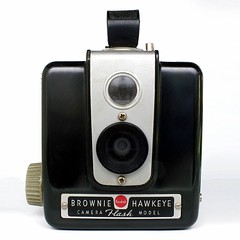
|
| Kodak Brownie Hawkeye Flash model image by Kenneth Dwain Harrelson (Image rights) |
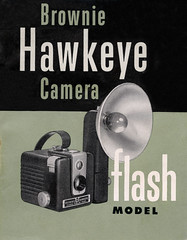
|
| Manual cover image by Kenneth Dwain Harrelson (Image rights) |

|
| Early non-"Flash" Hawkeye lacks flash sync attachment sockets image by cyanide45 (Image rights) |

|
| Brownie Flash (France) model image by photoli2009 (Image rights) |

|
| Brownie Fiesta name variant (see other Brownie Fiesta models) image by photoli2009 (Image rights) |
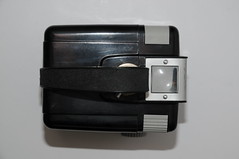
|
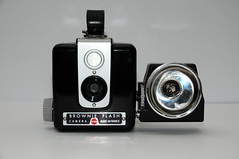
|
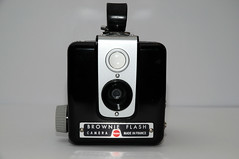
|
|
Kodak Brownie Flash variant | ||
References
- ↑ Kodak.com History of Kodak Cameras (archived)
- ↑ U.S. Camera - November 1954 - Photo Equipment Guide
- ↑ The article International Fixed Calendar at Wikipedia notes Kodak's use of this quixotic calendar reform scheme.
- ↑ Brownie Hawkeye flash review - Section four: modifying 120 film to use in the Hawkeye. at Kurt Munger's [1]
- ↑ 620 Film: How to use 120 film in your 620 camera by The Film Photography Podcast on YouTube
- ↑ Modifying a Brownie Hawkeye Flash with a tripod socket and cable release by Diwan Bhathal
- ↑ Hawkeye Conversion Project by Pete Lutz on Flickr
- ↑ Converting a Kodak Brownie Hawkeye to Electronic Flash by Charles Clemens
- ↑ How to flip the KBHF lens at the Film Photography Project
Links
- Kodak Brownie Hawkeye Flash Group on Flickr
- Kodak Brownie Hawkeye cleaning instructions and owners manual page at Kurt Munger's [2]
- Interview with a professional photographer who uses only the Hawkeye Flash
- Brownie Hawkeye on www.collection-appareils.fr by Sylvain Halgand (in French)
- France Pathé Brownie Flash at Sylvain Halgand's [3] (in French)
- How to renovate, clean and paint a Kodak Brownie Hawkeye by Dan Howard
- Rejuvenating Your Kodak Brownie Hawkeye by Kenneth Dwain Harrelson (On Ipernity)
- Rejuvenating Your Kodak Brownie Hawkeye by Kenneth Dwain Harrelson (On Flickr)
